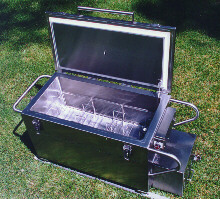WARM CHOW A HOT ITEM DURING COLD WEATHER OPS
Cpl. Chris Pence, USMC
MCB Quantico, Va.

The US Marine Corps Tray Ration Heating System
Cpl. Chris Pence, USMC
MCB Quantico, Va.

The US Marine Corps Tray Ration Heating System
MARINE CORPS BASE, Quantico, Va. -- When the weather is 35 degrees below zero, the only warmth for military personnel during cold weather operations comes from their own warm thoughts. Bundled up in parkas and anything else to keep warm, many consider themselves lucky to have a Meal-Ready-to-Eat that isn't frozen.
Unexpectedly, a HMMWV pulls into the campsite and, within five minutes, the smell of hot food comes floating on the air. It's MGySgt. Charlie Velez, Marine Corps field feeding project officer, and the new tray ration heating system.
"In the old days, there were troops on the front lines stuck with MREs or C-rations and such," Velez said. "Now, a commander has the flexibility to go out there and give the guys hot meals. Instead of rotating the troops off the front lines, you can change your whole strategy of how to fight because you're always going to be able to give them a hot meal.
"Morale is a big factor in any combat situation," he continued. "If the troops' morale isn't high, the combat efficiency of the unit is greatly decreased. While there are limitations to how much you can improve quality of life in combat, a hot meal gets the troops off MREs. I mean, MRE's are tough after about 10 days."
According to Velez, this is the biggest development for Marine Corps food services in the 28 years he has been in the Corps.
"We're cooking on World War II equipment," Velez said. "If you go to the Field Feeding Museum in Luxembourg, the display that shows Americans fighting Germans with a field kitchen has the same stuff in it we use today.
"When I went through the museum, the tour guide said, 'Boy, isn't it amazing. Look how archaic this stuff is.' I said to myself, 'yeah, and we're still using it.' "
The requirements document called for mobile field feeding equipment that can heat food on the move. Velez said this means that the food is cooking while traveling in the HMMWV.
According to Velez, when the equipment arrives at a site, it can be set up and have hot food ready to be served within five minutes. It is designed to feed 250 people at a stop, or 500 people in three stops.
The system is a self-contained unit. A case has 18 portions of food with trays and utensils for each serving. There is also a repair kit included with the heater that includes a spare burner.
"The Army tried for a long time to get this to work, but when the Marine Corps took the lead on the program, they discovered a new piece of technology called the Babbington Airtronic Burner," Velez said.
"Conventional high-powered burners shoot air and fuel through a nozzle, which gets clogged. This burner uses the principle of the whale. Simply put, when a whale sprays a plume of water, it is not spitting water, but air. There is a thin film of water that forms over the hole and when the air blows out, it atomizes the water, making it look like a spray.
"The burner uses the same principle," he explained. "It is a sphere with a little slit in it. Fuel runs over the top of the sphere and air is pushed through the slit. When fuel touches the slit, it is atomized for complete combustion."
This technology enables the burner to achieve a temperature of 2,000 degrees Fahrenheit.
Velez said that because the burner produces such high heat, there are no emissions. There are also several cross-over applications including medical uses.
The burner is operated on diesel fuel, but it can burn any combustible liquid, including liquids such as peanut oil. It can also handle fuel containing as much as 20 percent water, according to Velez.
It also has an automatic turn-off if the vehicle rolls over. A 30-degree tilt on either side or a 60-degree tilt front-to-back, causes the burner to shut off automatically.
"We're going to start fielding the new system in January," Velez said. "Soon, the Marines in the field will not have to rely solely on MREs or vacuum cans with food.
"I was in Twentynine Palms, Calif., a few weeks ago. They vacuum can 6,000 portions of food to the field that is 2 1/2 hours away. By the time they get there the food is cold."
There are 10 dinner menus and 10 breakfast menus. Velez said work is being done to develop 20 more dinner menus.
While tray rations have been around for several years, they are not widely used because there has been no previous cooking system. According to Velez, one way that has been used to cook the food is to fill a trash can with water and place a heater in it. Unfortunately, this can't be used to cook food on the go. It is either cooked before departing, which can allow the food to get cold, or it is cooked on site with the problem of filling the trash can with water.
"The new system is fantastic. There are a lot of things you can do with it," Velez added.
From: MARINE CORPS NEWS SUMMARY 26-95
Return to SeabeeCook's Homepage